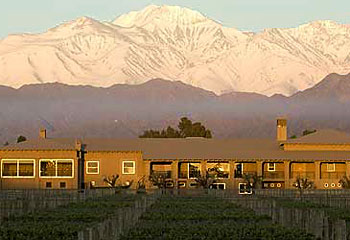Argentina's gourmet revolution
WITH its wineries, restaurants and boutique hotels, Argentina's Mendoza region is a cult secret among gourmands, writes Colin Barraclough

I SHOULD come clean at the start: wine moves my world. I quaff it in prodigious quantities. I wallow in the taste, the heady bouquet, the tints that hint at blood and fire. Visiting the vines that bore the grape, however, has always left me cold.
Perhaps it's the monotone spiel, recited by some student on summer break, or the scattering of statistics on production levels and the latest harvest. It could be the desultory half-glasses of immature white, unpleasantly warmed in the summer sun, or the weave to the car for those nerve-racking, touching-the-limit kilometres to the next tasting table.
And yet, after five days of romanesque indulgence and sensual excess in Argentina's sun-kissed Mendoza province, an area half again the size of Tasmania, running down the eastern slopes of the Andes, I'm forced to admit that my prejudices were a touch strident.
Committing body and mind to the sin of gluttony, I do little but meander from one table overladen with delectable dishes to another, breaking only to gaze at an emerald vista of trestled vines that leads the eye past breeze-disturbed Lombardy poplars to the snow-etched peaks of the Andean cordillera on the horizon.
Indeed, the hardest part of a visit to Mendoza is gearing oneself up for banquet-style dinners after what seem mere minutes since the banquet-style lunches. Thank God, I think many times, for the siesta.
In the past two years, Mendoza has undergone a gourmet revolution that mirrors the speed its premium-quality wines have burst on to the international wine scene. Once, aficionados scoffed at the province's robust, big-bodied malbecs and merlots, deeming them inconsistent and unsubtle, fit for consumption only by an unquestioning domestic public.
Fast-forward to 2006 and Mendoza's top-line output is regularly tipped as the next cult secret among the discerning.
"Good quality, decent price, great value," enthuses Darrin Siegfried, former president of the Sommelier Society of America. "A Mendoza wine tastes like you paid a whole lot more for it than you probably did."
Even better, the province has unveiled enough innovative bodega (wine estate) hotels, award-winning restaurants and organically produced olive oils, herbs and cheeses to merit a coveted place in the Great Wine Capitals network.
I begin my trip in sceptical frame of mind but soon have to admit that my base at Cavas Wine Lodge, a Spanish colonial-style hotel that opened a year ago, isn't bad at all.
Just 20 minutes from downtown Mendoza, it's peacefully set among 14ha of bonarda vines, with a year-round vista of the snow-covered Andes, an underground cava (cellar) stacked with dozens of notable Argentine labels and vinotherapy baths in the spa.
My 'room' turns out to be a vast adobe-built suite, set independently among the vines, complete with private patio, plunge pool and a roof terrace where a chill-out mattress offers a 360-degree view of the surrounding vineyard.
I have barely woken and returned to the hotel's terrace when Cecilia Diaz Chuit, Cavas's owner, invites me to join her and husband Martin. The couple are tasting a batch of recently delivered wine – ultimately they aim to offer about 300 labels – and want some tastebud assistance.
"Mendoza is so new to wine tourism that there's a freshness to the place that's uplifting," Cecilia says, passing me a glass of 2004 Tomero Semillon Chardonnay.
"People are still curious about outsiders here, and they like to explain to others what they do."
She's right: visitors receive a level of personal attention in Mendoza's vineyards rarely found in busier, more developed wine regions. In short, Mendoza's 'newness' is an asset.
At most wineries during my trip, the head winemaker accompanies me on a tour of the bodega; in the finca-based (estate) hotels, the owners are on hand to chat about their part in local history; in the restaurants, the executive chefspad out to explain how they created their cuisine.
At Finca Adalgisa, for instance, a tiny winery in Chacras de Coria on the outskirts of Mendoza, hotel manager Gabriela Furlotti leads me on a stroll through 2ha of malbec vines, shaded by cherry, apricot and hazelnut trees, that her grandmother bought in 1936.
"My family have been making wine here for more than a century," she tells me as we crack open one of the estate's 2003 malbecs, dipping into a tray of delicious tapas.
"We continue to work in the traditional way. We still use horses, and water comes to us by stream. We opened the house to guests four years ago, but we're not just selling beds, we're offering a slice of Mendoza's history."
History is ever-present in Mendoza. The intense sunshine that hammers down on its soil for 320 days in an average year and its 250mm annual rainfall make the province as dry as a desert.
Life comes in the form of melt-water from the Andes, irrigated through channels first built by the Incas in the 15th century.
Each vineyard is allotted access to irrigated water once a week, a cumbersome and antiquated system but one that gives growers far greater control over the vines' moisture levels than in more humid zones.
Vitally, Mendoza's extreme aridity also keeps fungal diseases at bay, allowing producers to grow vines on their own roots.
Only in the rocky Tupungato Valley, an area 80km south of Mendoza city, is flood irrigation unsuitable. Instead, wineries are treating the region as a vast laboratory, testing soil, drainage and altitude combinations to find the perfect match.
At Andeluna Cellars, a state-of-the-art facility built with American investment, winemaker Silvio Alberto shows me the creatively lit brick cellars that contain hundreds of barrels of cabernet, malbec and syrah (shiraz), grown at various altitudes.
"Within a 100km radius of here, growers can harvest from between 600m and 1500m in altitude," he says. "They can take a grape and place it exactly where it should be. They can choose the type of soil, the rocks, the drainage, even the climate. This is an incredible luxury."
Leaving Andeluna, I opt to end my trip as I began: in gastronomic excess. I take an outside table at La Tupina on the Vinos Altus estate, a restored adobe house set among cabernet vines and shaded from the midday sun by trails of flowering jasmine. The kitchen, known as the 'flame room', features a row of iron cauldrons (tupinas in Spanish) surrounding an open fire.
I'm tucking into my kid, cooked for three hours in goat's milk, when head chef Lucas Bustos steps out to check how it tastes.
"There is no more intimate way you can cook than in a bodega," he enthuses, eyeing the surrounding vines.
"You have the flames, the vines, the constant sun, the fresh produce raised in this earth. How can you ask for more?"
The question was rhetorical, but I considered it all the same. Bustos is right: I could ask for no more.



